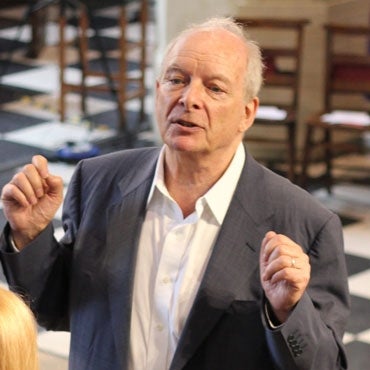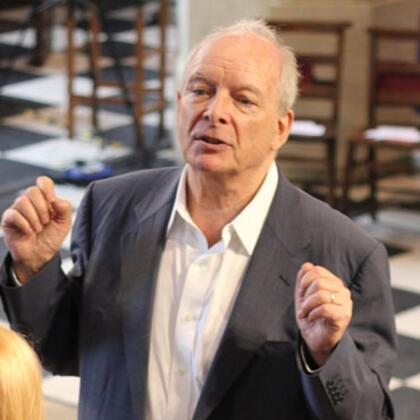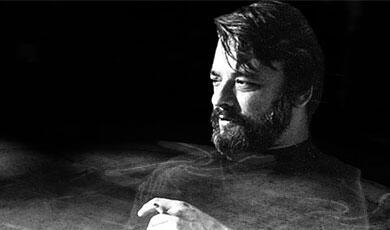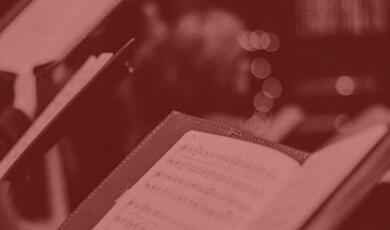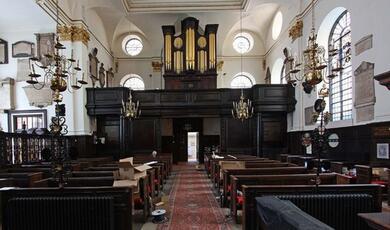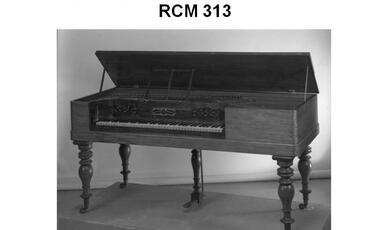Fakes, Completions and the Art of Borrowing
Share
- Details
- Text
- Audio
- Downloads
- Extra Reading
Although Mozart's unfinished Requiem is the most publicised composition requiring a helping-hand, there are many similar incomplete may-be masterpieces which have been assisted in some way, plus a number of well-loved classics which have very little connection with their supposed author ('Albinoni's Adagio' heads such a list). In addition composers of all periods have been open to the 'art of borrowing' - Handel was particularly active in this area and the reasons and results of his 'borrowings' shed a new light on some very familiar compositions.
Download Text
Gresham Lecture, 25 January 2011
Fakes, Completions and the Art of Borrowing
Professor Christopher Hogwood
You will see from this title the implication of wickedness and skulduggery: “Fakes, Completions and the Art of Borrowing”. It sounds a little dishonest, and some of it is. On the other hand, some of the music you listen to and some of the music with which you are most familiar is often not quite what it says on the tin. It claims to be one thing and may be something else so we ought to alert ourselves to this and also discover why some of these subterfuges take place. We need to think about them, and how many more there are to explore.
The first one I would like to attack is this art of borrowing because that is a follow-up to the topic of my last lecture on St Cecilia’s Day. You may remember we dealt with various settings of the poetry and praise of St Cecilia, and the music by Handel, which is very impressive and very Handelian. Some people were shocked to discover that this was, in quite a large part, drawn from recently published keyboard music by an Austrian composer, Muffat; and we played the pieces together and the relationship was blatant. Handel’s effort was just a sheer orchestration of the other music. It is true, however, that Handel, as we discovered, did wonderful things with his borrowings and, in his own day, the art of borrowing was not as illegal as it has become since the arrival of copyright. Nowadays, everybody would love to claim copyright infringement on their least idea. In the 18th Century, it was a compliment to a composer that another, and perhaps greater, composer thought to steal a little bit of their music and improve it. William Boyce said of Handel, very nicely, “He takes other men’s pebbles and polishes them into diamonds.” In fact, everybody was happy with the process. Last time we heard Handel not openly borrowing from other composers, but certainly borrowing.
Musically, I would like to start today with something you all know very well, and you may also have asked of this piece every year when you hear it or sing it a certain question.
[Recording plays]
I let it run as far as those wonderful shouts of wonderful counsellor because that is what many people remember from this piece. It is a great moment when these enormous acclamations suddenly break into the coloratura.
Purely as a side point to that, I once heard this piece of music in a very Southern Baptist church in America, where the audience was used to contributing to the proceedings. I then realised that Handel had obviously written it with a black Baptist audience in mind because you can fit it in very nicely because they sing “…and his name shall be called, wonderful, yeh, councillor, yeh!” The space is there to be filled, and this congregation certainly filled it.
It is a stunning moment. The question that used to be on my mind when I first sang Messiah, as a choirboy, and ever since, and is probably on your minds, is why he sets those words that way. The sentence “…for unto us, a child…” could be stressed in many places: “For unto us, a child is born”, “For unto us, a child is born” or “For unto us, a child is born”. The least likely of course, I think, is “For unto us, a child is born.” I still think it is bad accentuation of the text, but it is a beautiful piece. It is excused and explained by Handel’s source. This was Handel borrowing not from others but from one of his own Italian duets with the normal sort of love words – “no di voi non vo fidarme, No, I cannot trust you anymore.” It was sung by two sopranos. It is exactly the same music with which you are familiar, except the sentiment, the language and the speed are different. It has an absolute accentuation of this “No”, “For”. It fits the Italian, but it does not fit the English, and you will discover there are none of these marvellous shouts of wonderful counsellor. The compositional genius of Handel was in being able to take the duet; stretch it from a two-part duet into a four-part chorus – which itself is technically genius - and then insert something that was never originally there.
[Recording plays]
It is a beautiful piece. It is Handel’s own, but, even in this instance, he borrowed it artfully and you get paid back more than was borrowed. The way it is reused in Messiah is extremely uplifting and will always be a favourite chorus of most people, despite the bad English accentuation. So the art of borrowing, in that instance, is certainly an art, and it is in that sort of context that one has to take the 18th Century view. The normal simile in the 18th Century was that of a bee. Jonathan Swift writes very nicely about the art of the bee, flying from flower to flower, taking what is necessary and what it likes, a little nectar from each, returning to what he terms “the workshop” and producing what cannot be produced by any other means: honey. This was how they saw a composer like Handel, who was not unique in borrowing but perhaps the scale of his borrowings was rather stunning for most people to discover, and we are still discovering things that we thought were echt Handel that turn out to be echt borrowing of Handel of somebody else’s really rather nice idea, be it Telemann or Moffat or any number of contemporaries or near-contemporaries of him, turned into something that we now would call 100% typical Handel. Again, one needs to read carefully what it says on the tin and you need to just be aware that quite a lot of what says Messiah on the tin is actually recycled contents of other works now masquerading as Messiah, but very convincingly and in the hands of a dramatist very nicely held together.
The second component of this slightly dishonest lecture is the more criminal one, the faking of things; pieces that are not what they say they are on the tin. Purcell’s Trumpet Voluntary is one thing. It is a genuine piece, but it is not by Purcell, and that was what Henry Wood called it. It is by Jeremiah Clark. We need to re-label that tin and give back to Jeremiah Clark his very nice melody and accompaniment.
There’s the Adelaide concerto by Mozart which is a violin concerto, rediscovered at the beginning of the 20th Century. It is no such thing. It is a complete fake as is the Handel viola concerto which was rewritten by Casadesus. There is a lot of Kreisler. If you started your days playing the violin with some of those small Kreisler pieces, it says “Air by Lully, Arranged by Kreisler”, but in fact, it is 100% Kreisler. Lully, as you can tell from the style, never had a look-in on it.
About 10 years ago, there was the sudden discovery of six sonatas by Haydn for keyboard that were published and a great fuss was made of them. They were performed, they were even recorded, and everybody was very intrigued because Haydn had kept a catalogue of his music and so we had the opening two bars of most pieces that he had written, and these six sonatas all answered up. There were six sonatas for which we had previously only known the opening two bars that had disappeared. It was wonderful that they had been rediscovered in an attic and come to light. They were slightly curious in harmony and phraseology, but seemed to have fooled the musicologists for about six months, until somebody, who did not have to be a great expert, pointed out that quite a few of them were written in biro so they bit the dust! You can still buy the record, and I think you can still buy the music, but I think, somewhere, somebody has admitted that the original manuscript is in biro.
There was a lady called Rosemary Brown, you may remember, also about 20 years ago, who was a spiritualist and had contact with the great composers and began taking down, in a trance, lost works, or perhaps newly composed works by Liszt and any number of people. They were recorded. They were put into concert. Peter Katin, the concert pianist, played these. I think it was Anthony Hopkins, who used to entertain us so nicely on the BBC, who said, rather scathingly, that he felt, in her spiritual wanderings, that she had been spending rather more time with Rogers and Hammerstein than she had with Liszt, Bach, Schumann or Greig. Anyway, these pieces, again, were published, broadcast, recorded and much applauded. After 15 years of doing this, she admitted it was all a hoax – she was writing them herself. Just in case you are worrying, the Pachelbel Canon was by Pachelbel!
Having said that, I must now subtract another very popular work which features in nearly every recording that contains Pachelbel’s Canon. This, of course, is the famous “Adagio for Strings and Organ on Two Thematic Ideas on Two Thematic Ideas and a Figured Bass” by Albinoni, reconstructed by Remo Giazotto. This first appeared in 1958, and it has become very popular – the Albinoni Adagio is a great baroque hit. Remo Giazotto was a man who did a lot of work in Italian radio. He was a critic. He was a biographer; he wrote a biography of Vivaldi and Samartini, as well as a catalogue and a biography of Albinoni. He is not known to have edited any other music than this piece, and the difficulty with tracking down an Albinoni piece is the fact that in the last War the library in Dresden was very heavily destroyed which meant that about 200,000 volumes were destroyed, including quite a lot of manuscript material. Unfortunately, in Dresden, they had collected together most of the autograph and original manuscript source material for Albinoni. So, if you hunt for these snippets that Giazotto said he had used, you will not find them in the library in Dresden, which is where he said they were. His starting point, according to his preface, was two little snippets of figured bass – i.e. the bass line of a piece, the harmony, and two bars of a violin part. He suspected it might have been a violin sonata or possibly part of a trio sonata.
Well, if you listen to the beginning, you do think for a moment that you are perhaps in the baroque world. Here is the opening.
[Recording plays]
From that, you can pick at least a couple of hints that will convince you that you are in the 18th Century. One is the pizzicato descending bass, like a ground bass. We have heard many chaconnes that have this same sort of easy-moving harmonic structure. We have also heard quite a lot of baroque pieces that have a surfeit of mordance in them. Everybody remembers the beginning of the Toccata and Fugue in D Minor which goes da-da-dum. That has become a trademark of “the baroque”. If you want to make something sound more baroque, instead of playing a single note, you just put this ornament ‘da-da-dum’ on it and that has already come three or four times in that little organ introduction to these. Those are there to give the reconstructed 18th Century flavour and that was part of the bass line that you heard that came from, he told us, an existing fragment.
As you plough on in this piece though, I am afraid the rhetoric does soon develop into something that might make even a first-time listener wonder whether you can honestly think this is 18th Century.
[Recording plays]
Well, certainly, the rhetoric is beyond what we might expect from early 18th Century violin writing, but you could put that down to the orchestration as in the middle of the last century, when people were listening to baroque music, it was very often in colourful versions. The real music was dressed up to suit the mood of the times or the mood of the cinema. Schakowsky’s arrangement of Bach, Elgar’s arrangements of Bach, Thomas Beacham’s arrangement of Handel – they were all based on real music, but in a form of dress and colour that had been applied much later to make full use of the resources around. You could say that was a smaller gesture from Albinoni and it was built up somewhat to suit the rhetoric of the string orchestra nowadays, but you still have the feeling that underneath all this is something linking it quite closely to the famous piece that has the same structure, melody and bass that we all take as being pure 18th Century.
[Recording plays]
Many people have capitalised on that, but nobody has yet proved that it is not Bach, so it is from the Third Orchestral Suite, and whatever you do to it, even if you are Procol Harum and you extract from it that wonderful pop thing called “A Paler Shade of White” or “A Whiter Shade of Pale”, the original is unharmed, so no criminal damage is done, and it is genuine Bach. That has so much of the feeling of the Albinoni that you feel, again that it is a passport to authenticity.
Let us check out an actual Albinoni adagio. There are quite a lot of them. They are usually the ones that survive, which means the ones that were mostly in print in his lifetime, so were not able to be destroyed by one bomb in Dresden. They are elegant constructions, mostly very harmonically based, and with a simple melody. In this case, it is a little extract from an oboe concerto, but you will find just undulating harmony, which fills up the texture and the mood of the piece; otherwise, nothing very much more than that.
[Recording plays]
That is quite a different world.
The whole thing came unravelled when there was a need to re-copyright the adagio. Giazotto copyrighted in 1958, as a reconstruction of Albinoni fragments, where he was the musicologist in charge. When it had to be re-copyrighted in 1979, he very interestingly copyrighted it as a complete composition by himself. He did not publicise the fact – he only died a few years ago, in fact, he lived into this century – and the truth of the matter is that there was no Albinoni in the piece at all. It will still go on being called the Albinoni Adagio, but it is, unfortunately, a Fifties’ fake.
The interesting thing here is not so much that it is a fake or that he fooled so many people for so much of the time, but the reasons why it proved compatible with what people were expecting. Well, part of it is by analogy I think, that the Bach Air on the G String gives you, immediately, a family to which it can belong. This opening series of pizzicato, the bass notes, are genuinely a type of chaconne theme. This was lingua-Franca for the 18th Century - you did not have to have a fragment of Albinoni to take a descending scale as a harmonic pattern and repeat it; however, it is of the period.
I also think the lushness of the transcription called up, certainly in the last century, memories of Henry Wood, Elgar, and Schakowsky. Because they had transcribed genuine pieces, this form of lushness attached to the name Albinoni passed very easily. The mordants, at the beginning, that I explained, were again a subconscious way of convincing people this was baroque phraseology. I think even the fact that a musicologist was involved, that it was said “Albinoni, reconstructed by”, gave people a feeling of security which perhaps they no longer quite have since the musicologist passed the biro handwriting in Haydn.
There is an element of our memories of museum visits, where we find Grecian statues, reconstructed. When you enquire into it you find that it was a fragment of a nose, a bit of an ear and one fingernail, and it has suddenly become a complete statue. We believe it is possible to reconstruct or to extrapolate from small bits, and so the myth grew up round it.
The real place for this music appears to be Giazotto’s only composition and, although I have tried very hard for a long time to find a manuscript of it, there appears to be no manuscript – not even in biro. I would love to know where the original is that the print was made from.
The real place for the music was proved by its use in cinema – it is the making of the Orson Welles film of the Kafka – “The Trial”. Remember those wonderful scenes filmed in one of the main Paris stations, where thousands of desks and secretaries are all mindlessly working away to the commands of the unseen dictator and Mr K is wandering around, desperately trying to find out what he has been accused of and when his trial is going to take place, and as he becomes more and more worried about his future, or lack of future, the music of the Albinoni Adagio gets louder and louder over him. That is absolutely perfect and it is in that form of art, I think, that the piece was originally dressed up.
It also does very well, I am glad to find, in a very big arena, played very loudly, in the pop world.
[Recording plays]
We wondered whether we dared play it to you at the volume that a pop enthusiast would expect, but I think we would have medical complaints if we did! That is ‘The Doors’. It really seems to fit quite happily there, and certainly no longer fits at all into the 18th Century.
It is fake, and what it says on the tin is completely untrue, so return it with a complaint to manufacturers and say please put it out as a very nice romantic piece by Mr Giazotto, because I am sure his widow needs the income and it is very creditable for what it really is rather than what it is pretending to be.
The third category is the most interesting category of today’s borrowings, completings and facings, is the business of completions, because this is a genuine situation that occurs quite a lot in all arts.
In music, there are many pieces, of course beginning with the one that uses “unfinished” in its title: the Schubert symphony, also Mahler’s 10th Symphony, Lulu and Turandot. If you go to see the Puccini Turandot, remember Act III is not by Puccini. We only had fragments of Elgar’s 3rd Symphony; Bartok Viola Concerto; Bach, the Art of Fugue just runs out in the middle of one piece and trails off into nothing. For a modern audience, you can do various things, but one thing is for sure: Bach did not expect the piece to end with it trailing off romantically into unfinished lines. He expected a complete piece. Most people then buckle to and do a little remedial work on these pieces to make them performable, to give the sort of impression and certainly the feeling of completeness that was always the intention of the creator.
Some pieces, however, we accept incomplete. People have more of a frisson by The Art of Fugue fading as Bach drew his last breath; in the romantic image – not true, but you like to see it gradually fading out to nothing. We do not, on the whole, feel the same about the Canterbury Tales, although that is unfinished. We know what Chaucer was originally intending – he never got there. We have a lot of nice tales, and who knows what the end might have been, so nobody has, as far as I know, tried to write more and come to a climatic conclusion. Byron, Don Juan, is also a wonderful and amusing longish poem, but it was meant to be twice as long.
You sometimes have to wait. This is like unfinished architecture: the sacred family cathedral in Barcelona is one we are still waiting for, but have patience. The Cologne Cathedral of course was begun in Cologne in 1248 and finished in 1880, so you had to be patient for 632 years before the piece was finished.
The piece in hand that I would like to look at to decide what the renovation should consist of, or might consist of, is the Mozart Requiem because this carries with it the most myths, and there is more of it of course than there ever could have been for the Albinoni, but the thing is, the romance of it has rather obscured the more accurate picture. For a start, Mozart left more than 100 unfinished pieces, so it was not unusual for him to break off a piece and move on to another. This usually happened when he became tired of the piece as it was not going the right way. The most common reason was that the occasion for which it had been commissioned had disappeared, for example, if it was going to be a wedding symphony and then they called off the wedding a week before, Mozart did not take the romantic idea of “I must complete my master work”. He stopped the minute he heard of the divorce and went on to another piece that might produce better money. Thus, a lot of these pieces were suggestions for concerts, hopes for concert tours, concertos that were going to be part of a subscription series in Vienna, to which not enough people subscribed and therefore he did not write the rest of the music.
Requiem is a little different, in that he was very much trying to finish it alongside a couple of operas at the same time – Magic Flute and Clemenza di Tito. He was very pushed, and so the number of things on his work desk grew and he was trying to get to the end of them. Unfortunately, Requiem was one where, although we can tell what the plan of a lot of it was, it was not fully written out.
His widow had a problem on her hands. She did not have much money. There was no automatic copyright in those days. All you could do was sell works. Her hope was, out of her husband’s nachlass, to collect together enough complete pieces to attract and sell to publishers. She talked to a number of publishers and made good sales of manuscripts of string quartets, church masses and symphonies; a lot of stuff that Mozart had performed in a complete form but had remained in manuscript. However, there was a price already attached to this requiem. It was a commission and she knew money was going to be available, but she could not, for liturgical reasons if nothing else, hand over an incomplete requiem – something had to be done. Therefore, she passed it around her friends and her husband’s friends. The composer Eybler was the first one to get it, a few others took it up, and then returned it and said that it was too unfinished – there were whole movements missing. The Benedictus and the Sanctus were not there, the Angus Dei was hardly there; it was only really half a requiem. Even in that half, only some of the vocal lines and none of the orchestrations existed in many of the movements. It was too skeletal for them.
However, Sussmayr was a close friend of the family and he took on the job. It was interesting that both Eybler and Sussmayr had worked with Mozart while he was alive, and working alongside Mozart, they were aware of his handwriting. One of the slightly crooked things about the history of the completion of the Requiem is that Sussmayr, in writing it out, tried to make his handwriting look a little bit more like Mozart’s. He filled out the rest of the piece, inventing complete movements himself, where there was nothing from Mozart. He put Finus at the end, and it was passed off by Constanze as a complete requiem, finished just in time, by her husband.
Some of the things Sussmayr did, we know were in Mozart’s mind. It was very traditional to open a mass with a Kyrie Requiem and then the Kyrie and then to repeat that same music at the end. Usually, the excuse was sic erat in principio - as it was in the beginning - and the musical equivalent was to repeat the beginning music and so you had a nice formality to the whole thing. However, while that solved the very end of the piece it did not solve some very alarming moments in the middle.
The one I would like to pick on, where we do know what happened is the Lacrimosa setting. That is part of the sequence for the burial of the dead and it is mournful. It begins with a beautiful mournful figure from the strings, sighing away, and is followed by these homophonic chords while the chorus slightly stutter about - crying in the face of death, and, at a certain, very dramatic moment, with a whole pile-up of harmonies, getting louder and louder, Mozart simply stops.
[Recording plays]
That is where he died. That left some challenge to Sussmayr! You have to decide what could come next. There are many possibilities. Let us have the next example and you will hear Sussmayr goes on with a nice sort of waltz.
[Recording plays]
It is not bad. It gets better as it goes along but those first two bars after the break off of those big harmonies are always, I think, a horrific disappointment. It is pure dancehall music.
One problem, and most choruses will tell you this is a problem, is that if you have had the breath to build up that enormous sequence of harmonies to the top, one thing that would be awfully nice would be if your composer was sufficiently sensitive to give you a moment to get your breath back by putting in some orchestra before it goes on. That is one option.
The other thing is to take a different melodic line afterwards that relates to what has gone before and so takes you up the mountain and then brings you down the other side.
Here is another sample of another completion. This is not Sussmayr.
[Recording plays]
I think that is interesting both for the melody that is chosen to carry on from the point that Mozart broke off, but also for the instrumental extension that goes on afterwards. It reminds you that, at the very beginning of the Requiem, you were very aware of sobbing strings, but the harmonic business was taken care of by this very melancholy, funereal sonority of two basset horns, a type of clarinet, and two bassoons, which gave a very gurgly and low-set dark quality. The reason of course is that the people playing these instruments were some of Mozart’s closest friends. They were the Stadler Brothers. Anton Stadler was the man for whom the Clarinet Concerto and the Clarinet Quintet had just been written shortly before, and they were being featured at the beginning of the Requiem. Surely, this reconstructor says, they would be given slightly more share in the Requiem had Mozart finished it than they were given by Sussmayr, who basically ignores them – you do not hear very much clarinet sound ever again in the piece, but that is an important element.
A second element that Sussmayr was not aware of was that the whole construction of the Requiem was much more bound together thematically and it was a sort of cyclic thing. Mozart was using the Requiem theme as it was sung at the beginning – [sings] – it is the plain chant line. That was a motto that Sussmayr had not noticed and therefore never used again.
Let us remind ourselves of the very opening of the piece because this gives the clues to the working blocks with which you might think to make your own reconstruction after that dramatic moment. Here is Mozart’s opening.
[Recording plays]
I would pick out various elements out of that. The first is this sort of subservience of the string accompaniment – oom-cha, oom-cha – it is very similar to the ta-ra, ta-rum, the little sighing that goes on in Lacrimosa. You could make a logical connection there. A second is the use of the winds to set the colour, to move the harmony, to be the leading force in fact, until the voices come in, and when the voices come in, a third element that is useful to note is that they sing a version of the plain chant Requiem, so the notes that the basses introduce and then the chorus all take up is the outline of the plain chant.
By taking at least those first two, here is another possible way of going on after the Mozart death moment: that is, to make a combination of what the winds did at the opening, remind us of that, set against – it turns out to work very nicely – the Lacrimosa shapes that the violins were giving you from the beginning of Lacrimosa, which again was a genuine Mozart. He sketched that opening with the violin part, so we know we are on safe ground. Thus, at least for a bar or two after that break moment, you are dealing with material which we know would be familiar and sympathetic to Mozart.
After that, you have a number of choices. I would avoid the Viennese waltz. I would avoid suddenly shouting or anything like that. You would think it has to be softer, homophonic, with nice harmonies and a little ritualistic. See what you think of it! The nicest thing is you get to take a breath after you have made that big moment.
[Recording plays]
Well, you will say immediately, “What’s happened? He has forgotten the Amen.” It is true. If you are used to Sussmayr the end of Lacrimosa is Dona Requiem, Amen, part of the text. It is missing there – what has gone on? Well, on the desk, alongside all the fragments that Mozart left behind for people to sort out were various sketches of contrapuntal fugues and bits and pieces that were not identifiable. Therefore, they were put together in a volume and labelled “Fragments – Unidentifiable”. Sussmayr looked at them all, put them to one side, and wrote his completion of the Lacrimosa. Amongst the pieces he turned over but failed to recognise was one interesting fragment, which was four bars of a fugue, where Mozart was working on how to get the voices in the fugue to combine for four-part writing, and on a fugue subject which worked in inversion. It did not take a lot of intelligence, I think, for a musicologist to look at the fugue subject, first of all, extract that, and say “What is this?” The fugue subject turns out to be the inversion of the Requiem theme, so instead of [sings], it is [sings]: it rises by one, and then falls, instead of falling by one and then rising. So, other things being equal, this being a manuscript from the end of Mozart’s life, and the theme being a fugue on the inversion of the Requiem subject, surely it was part of something he was working on for the Requiem. The likeliest thing, if you invert the Requiem theme and turn it into something - the obverse of Requiem - is a very suitable Amen, on a cheerful, upbeat, triumphant sort of note, designed to dispel the mood of the Lacrimosa. Thus, just from these four bars, fugues being so closely integrated, you can separate out the elements and, with not too much of your own invention, put together a quite convincing four-part fugue which makes an Amen that hangs together, includes everything that Mozart left us from that unidentified, untexted piece. It gives us, I think, a much more optimistic and upbeat ending to this whole sequence that had begun with Dies Irae and all the fearful and Lacrimose moments. Mozart apparently intended to tell us, at the end, that everything would be alright.
[Recording plays]
I like that completion! I go away feeling much better!
So, fakes, I disapprove of; borrowing is fine certainly, if you can improve; and completions give rise to a lot of questions and sometimes give rise to a lot of choices you could make when now performing whichever version of Requiem you like to do, but some I think can be very uplifting and very enlightening.
©Professor Christopher Hogwood, Gresham College 2011
Part of:
This event was on Tue, 25 Jan 2011
Support Gresham
Gresham College has offered an outstanding education to the public free of charge for over 400 years. Today, Gresham College plays an important role in fostering a love of learning and a greater understanding of ourselves and the world around us. Your donation will help to widen our reach and to broaden our audience, allowing more people to benefit from a high-quality education from some of the brightest minds.


 Login
Login
